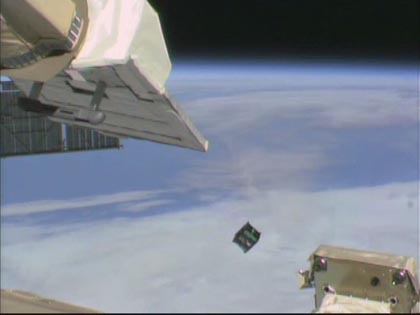This is an archive of information released in the past.
Disclaimer: It may contain broken links or outdated information. Some parts may not function in current web browsers.
*Visit https://humans-in-space.jaxa.jp/en/ for the latest information.

Experiment
- News
- Kibo Utilization Strategy
- Kibo Utilization Plan
- List of JAXA's Utilization Themes
- Experiment Facilities
- Space Environment Utilization
- Archive
Brazilian AESP-14 CubeSat was deployed from Kibo
On February 5, 2015, at 9:50 p.m., a Brazilian microsatellite called AESP-14*1 was deployed from the Japanese Experiment Module "Kibo" by the command issued from the JAXA Flight Control Team (JFCT) in the JAXA Tsukuba Space Center (TKSC). AESP-14 was developed by Technological Institute of Aeronautics (ITA) with support from the Brazilian Space Agency - AEB and National Institute For Space Research (INPE).
This marks the sixth (56th satellite) deployment from Kibo and the third (10th satellite) deployment using the JEM Small Satellite Orbital Deployer (J-SSOD).
J-SSOD is a mechanism for deploying satellites designed in accordance with CubeSat design specification (10 cubic cm) that transfers the satellites from the Kibo's airlock to space environment and releases them on orbit.
AESP-14 was delivered to the International Space Station (ISS) on January 12 by the Dragon spacecraft (SpX-5). For the deployment, it was set in the Kibo's airlock on January 29, followed by the airlock depressurization on February 4.
AESP-14's operation will be performed by the Brazilian space institution.
For the deployment, Prof. Dr. Pedro Lacava and three engineers who engaged in the satellite development visited TKSC to monitor the AESP-14 deployment.
In this way, JAXA is, and will be providing Kibo utilization opportunities with not only ISS program partners but non-partner countries.
- See also: Project AESP14 Cubesat - ITA (Developer's website)
*1: AESP-14 takes an opportunity of Kibo's paid utilization and is deployed by Japan Manned Space Systems Corporation (JAMSS) at the request of Brazilian Space Agency.
*All times are Japan Standard Time (JST)
| Copyright 2007 Japan Aerospace Exploration Agency | Site Policy |

